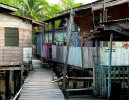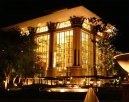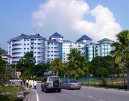| Introduction - Brunei: |
Country | Brunei |
|
Background | The Sultanate of Bruneis influence peaked between the 15th and 17th centuries when its control extended over coastal areas of northwest Borneo and the southern Philippines. Brunei subsequently entered a period of decline brought on by internal strife over royal succession, colonial expansion of European powers, and piracy. In 1888, Brunei became a British protectorate; independence was achieved in 1984. The same family has ruled Brunei for over six centuries. Brunei benefits from extensive petroleum and natural gas fields, the source of one of the highest per capita GDPs in Asia. |
|
|
|
| Location - Brunei: |
Location | Southeastern Asia, bordering the South China Sea and Malaysia |
|
Geographic coordinates | 4 30 N, 114 40 E |
|
Map references | Southeast Asia |
|
Area | total: 5,770 sq km
land: 5,270 sq km
water: 500 sq km |
|
Area comparative | slightly smaller than Delaware |
|
Land boundaries | total: 381 km
border countries: Malaysia 381 km |
|
Coastline | 161 km |
|
Maritime claims | territorial sea: 12 nm
exclusive economic zone: 200 nm or to median line |
|
Climate | tropical; hot, humid, rainy |
|
Terrain | flat coastal plain rises to mountains in east; hilly lowland in west |
|
Elevation extremes | lowest point: South China Sea 0 m
highest point: Bukit Pagon 1,850 m |
|
Natural resources | petroleum, natural gas, timber |
|
Land use | arable land: 2.08%
permanent crops: 0.87%
other: 97.05% (2005) |
|
Irrigated land | 10 sq km (2003) |
|
Natural hazards | typhoons, earthquakes, and severe flooding are rare |
|
Environment current issues | seasonal smoke/haze resulting from forest fires in Indonesia |
|
Environment international agreements | party to: Biodiversity, Desertification, Endangered Species, Environmental Modification, Hazardous Wastes, Law of the Sea, Ozone Layer Protection, Ship Pollution
signed, but not ratified: none of the selected agreements |
|
Geography note | close to vital sea lanes through South China Sea linking Indian and Pacific Oceans; two parts physically separated by Malaysia; almost an enclave within Malaysia |
|
| People - Brunei: |
Population | 374,577 (July 2007 est.) |
|
Age structure | 0-14 years: 27.8% (male 53,512/female 50,529)
15-64 years: 69% (male 130,134/female 128,488)
65 years and over: 3.2% (male 5,688/female 6,226) (2007 est.) |
|
Median age | total: 27.2 years
male: 27.3 years
female: 27.1 years (2007 est.) |
|
Population growth rate | 1.81% (2007 est.) |
|
Birth rate | 18.56 births/1,000 population (2007 est.) |
|
Death rate | 3.26 deaths/1,000 population (2007 est.) |
|
Net migration rate | 2.79 migrant(s)/1,000 population (2007 est.) |
|
Sex ratio | at birth: 1.05 male(s)/female
under 15 years: 1.059 male(s)/female
15-64 years: 1.013 male(s)/female
65 years and over: 0.914 male(s)/female
total population: 1.022 male(s)/female (2007 est.) |
|
Infant mortality rate | total: 13.12 deaths/1,000 live births
male: 15.72 deaths/1,000 live births
female: 10.4 deaths/1,000 live births (2007 est.) |
|
Life expectancy at birth | total population: 75.3 years
male: 73.12 years
female: 77.59 years (2007 est.) |
|
Total fertility rate | 1.97 children born/woman (2007 est.) |
|
Hiv aids adult prevalence rate | less than 0.1% (2003 est.) |
|
Hiv aids people living with hiv aids | less than 200 (2003 est.) |
|
Hiv aids deaths | less than 200 (2003 est.) |
|
Nationality | noun: Bruneian(s)
adjective: Bruneian |
|
Ethnic groups | Malay 67%, Chinese 15%, indigenous 6%, other 12% |
|
Religions | Muslim (official) 67%, Buddhist 13%, Christian 10%, other (includes indigenous beliefs) 10% |
|
Languages | Malay (official), English, Chinese |
|
Literacy | definition: age 15 and over can read and write
total population: 92.7%
male: 95.2%
female: 90.2% (2001 census) |
|
| Government - Brunei: |
Country name | conventional long form: Brunei Darussalam
conventional short form: Brunei
local long form: Negara Brunei Darussalam
local short form: Brunei |
|
Government type | constitutional sultanate |
|
Capital | name: Bandar Seri Begawan
geographic coordinates: 4 53 N, 114 56 E
time difference: UTC+8 (13 hours ahead of Washington, DC during Standard Time) |
|
Administrative divisions | 4 districts (daerah-daerah, singular - daerah); Belait, Brunei and Muara, Temburong, Tutong |
|
Independence | 1 January 1984 (from UK) |
|
National holiday | National Day, 23 February (1984); note - 1 January 1984 was the date of independence from the UK, 23 February 1984 was the date of independence from British protection |
|
Constitution | 29 September 1959 (some provisions suspended under a State of Emergency since December 1962, others since independence on 1 January 1984) |
|
Legal system | based on English common law; for Muslims, Islamic Sharia law supersedes civil law in a number of areas; has not accepted compulsory ICJ jurisdiction |
|
Suffrage | none |
|
Executive branch | chief of state: Sultan and Prime Minister Sir HASSANAL Bolkiah (since 5 October 1967); note - the monarch is both the chief of state and head of government
head of government: Sultan and Prime Minister Sir HASSANAL Bolkiah (since 5 October 1967)
cabinet: Council of Cabinet Ministers appointed and presided over by the monarch; deals with executive matters; note - there is also a Religious Council (members appointed by the monarch) that advises on religious matters, a Privy Council (members appointed by the monarch) that deals with constitutional matters, and the Council of Succession (members appointed by the monarch) that determines the succession to the throne if the need arises
elections: none; the monarch is hereditary |
|
Legislative branch | Legislative Council met on 25 September 2004 for first time in 20 years with 21 members appointed by the Sultan; passed constitutional amendments calling for a 45-seat council with 15 elected members; Sultan dissolved council on 1 September 2005 and appointed a new council with 29 members as of 2 September 2005
elections: last held in March 1962 (date of next election NA) |
|
Judicial branch | Supreme Court - chief justice and judges are sworn in by monarch for three-year terms; Judicial Committee of Privy Council in London is final court of appeal for civil cases; Shariah courts deal with Islamic laws (2006) |
|
Political parties and leaders | Brunei National Solidarity Party or PPKB [Abdul LATIF bin Chuchu]; National Development Party or NDP [YASSIN Affendi]
note: Peoples Awareness Party or PAKAR [Awang Haji MAIDIN bin Haji Ahmad] was deregistered in 2007; parties are small and have limited activity |
|
Political pressure groups and leaders | NA |
|
International organization participation | APEC, APT, ARF, AsDB, ASEAN, C, EAS, G-77, IBRD, ICAO, ICRM, IDB, IFRCS, IMF, IMO, IMSO, Interpol, IOC, ISO (correspondent), ITSO, ITU, NAM, OIC, OPCW, UN, UNCTAD, UNESCO, UPU, WCO, WHO, WIPO, WMO, WTO |
|
Diplomatic representation in the us | chief of mission: Ambassador Pengiran Anak Dato PUTEH
chancery: 3520 International Court NW, Washington, DC 20008
telephone: [1] (202) 237-1838
FAX: [1] (202) 885-0560 |
|
Diplomatic representation from the us | chief of mission: Ambassador Emil SKODON
embassy: Third Floor, Teck Guan Plaza, Jalan Sultan, Bandar Seri Begawan, BS8811
mailing address: PSC 470 (BSB), FPO AP 96507; P.O. Box 2991, Bandar Seri Begawan BS8675, Negara Brunei Darussalam
telephone: [673] 222-0384
FAX: [673] 222-5293 |
|
Flag description | yellow with two diagonal bands of white (top, almost double width) and black starting from the upper hoist side; the national emblem in red is superimposed at the center; the emblem includes a swallow-tailed flag on top of a winged column within an upturned crescent above a scroll and flanked by two upraised hands |
|
| Economy - Brunei: |
Economy overview | Brunei has a small well-to-do economy that encompasses a mixture of foreign and domestic entrepreneurship, government regulation, welfare measures, and village tradition. Crude oil and natural gas production account for just over half of GDP and more than 90% of exports. Per capita GDP is among the highest in Asia, and substantial income from overseas investment supplements income from domestic production. The government provides for all medical services and free education through the university level and subsidizes rice and housing. Bruneis leaders are concerned that steadily increased integration in the world economy will undermine internal social cohesion. Plans for the future include upgrading the labor force, reducing unemployment, strengthening the banking and tourist sectors, and, in general, further widening the economic base beyond oil and gas. |
|
Gdp purchasing power parity | $9.557 billion (2006 est.) |
|
Gdp official exchange rate | $9.531 billion (2005 est.) |
|
Gdp real growth rate | 0.4% (2005 est.) |
|
Gdp per capita ppp | $25,600 (2005 est.) |
|
Gdp composition by sector | agriculture: 0.9%
industry: 71.6%
services: 27.5% (2005 est.) |
|
Labor force | 180,400 (2006 est.) |
|
Labor force by occupation | agriculture: 2.9%
industry: 61.1%
services: 36% (2003 est.) |
|
Unemployment rate | 4% (2006) |
|
Population below poverty line | NA% |
|
Household income or consumption by percentage share | lowest 10%: NA%
highest 10%: NA% |
|
Inflation rate consumer prices | 1.1% (2005) |
|
Budget | revenues: $3.765 billion
expenditures: $4.815 billion; including capital expenditures of $NA (2004 est.) |
|
Agriculture products | rice, vegetables, fruits; chickens, water buffalo, cattle, goats, eggs |
|
Industries | petroleum, petroleum refining, liquefied natural gas, construction |
|
Industrial production growth rate | 1.8% (2005 est.) |
|
Electricity production | 2.913 billion kWh (2005) |
|
Electricity consumption | 2.726 billion kWh (2005 est.) |
|
Electricity exports | 0 kWh (2005) |
|
Electricity imports | 0 kWh (2005) |
|
Oil production | 219,300 bbl/day (2006) |
|
Oil consumption | 14,900 bbl/day (2006 est.) |
|
Oil exports | 205,600 bbl/day (2006) |
|
Oil imports | 660.1 bbl/day (2004) |
|
Oil proved reserves | 1.35 billion bbl (1 January 2005) |
|
Natural gas production | 11.5 billion cu m (2004 est.) |
|
Natural gas consumption | 2 billion cu m (2004 est.) |
|
Natural gas exports | 9.5 billion cu m (2004 est.) |
|
Natural gas imports | 0 cu m (2004 est.) |
|
Natural gas proved reserves | 390.8 billion cu m (1 January 2005 est.) |
|
Exports | $6.247 billion f.o.b. (2005 est.) |
|
Exports commodities | crude oil, natural gas, refined products, clothing |
|
Exports partners | Japan 31.2%, Indonesia 20.3%, South Korea 13.3%, Australia 11.7%, US 7.9% (2006) |
|
Imports | $1.481 billion c.i.f. (2005 est.) |
|
Imports commodities | machinery and transport equipment, manufactured goods, food, chemicals |
|
Imports partners | Singapore 30.7%, Malaysia 18.4%, UK 7.8%, Japan 5.4%, China 5.3%, Thailand 4.4%, South Korea 4.1% (2006) |
|
Debt external | $0 (2005) |
|
Economic aid recipient | $NA |
|
Currency code | Bruneian dollar (BND) |
|
Exchange rates | Bruneian dollars per US dollar - 1.5886 (2006), 1.6644 (2005), 1.6902 (2004), 1.7422 (2003), 1.7906 (2002) |
|
| Communications - Brunei: |
Fiscal year | 1 April - 31 March |
|
Telephones main lines in use | 80,200 (2006) |
|
Telephones mobile cellular | 254,000 (2006) |
|
Telephone system | general assessment: service throughout the country is excellent; international service is good to Southeast Asia, Middle East, Western Europe, and the US
domestic: every service available
international: country code - 673; satellite earth stations - 2 Intelsat (1 Indian Ocean and 1 Pacific Ocean); digital submarine cable links to Malaysia, the Philippines, and Singapore (2006) |
|
Radio broadcast stations | AM 1, FM 2 (transmitting on 18 different frequencies), shortwave 0 (British Forces Broadcasting Service (BFBS) station transmits two FM signals with English and Nepali service) (2006) |
|
Television broadcast stations | 4 (includes 2 UHF stations broadcasting a subscription service) (2006) |
|
Internet country code | .bn |
|
Internet hosts | 27 (2005) |
|
Internet users | 165,600 (2006) |
|
| Transportation - Brunei: |
Airports | 2 (2006) |
|
Airports with paved runways | total: 1
over 3,047 m: 1 (2006) |
|
Airports with unpaved runways | total: 1
914 to 1,523 m: 1 (2006) |
|
Heliports | 3 (2006) |
|
Pipelines | gas 672 km; oil 463 km (2006) |
|
Roadways | total: 3,650 km
paved: 2,819 km
unpaved: 831 km (2005) |
|
Waterways | 209 km (navigable by craft drawing less than 1.2 m) (2007) |
|
Merchant marine | total: 8 ships (1000 GRT or over) 465,937 GRT/413,393 DWT
by type: liquefied gas 8
foreign-owned: 8 (UK 8) (2006) |
|
Ports and terminals | Lumut, Muara, Seria |
|
| Military - Brunei: |
Military branches | Royal Brunei Armed Forces (RBAF): Royal Brunei Land Forces, Royal Brunei Navy, Royal Brunei Air Force (Tentera Udara Diraja Brunei) (2005) |
|
Military service age and obligation | 18 years of age (est.) (2004) |
|
Manpower available for military service | males age 18-49: 103,885
females age 18-49: 93,024 (2005 est.) |
|
Manpower fit for military service | males age 18-49: 85,045
females age 18-49: 77,436 (2005 est.) |
|
Manpower reaching military service age annually | males age 18-49: 3,478
females age 18-49: 3,342 (2005 est.) |
|
Military expenditures percent of gdp | 4.5% (2006) |
|
Disputes international | Brunei and Malaysia are still considering international adjudication over their disputed offshore and deepwater seabeds, where hydrocarbon exploration was terminated in 2003 international legal adjudication; Malaysias land boundary with Brunei around Limbang is in dispute; Brunei established an exclusive economic fishing zone encompassing Louisa Reef in the southern Spratly Islands in 1984, but makes no public territorial claim to the offshore reefs; the 2002 Declaration on the Conduct of Parties in the South China Sea has eased tensions in the Spratly Islands but falls short of a legally binding code of conduct desired by several of the disputants |
|
This page was last updated on 16 September, 2007



